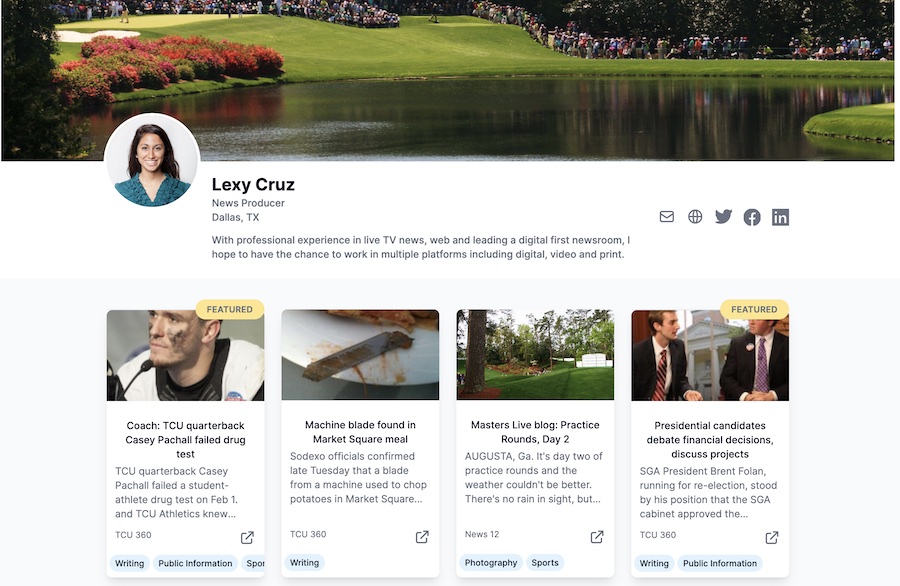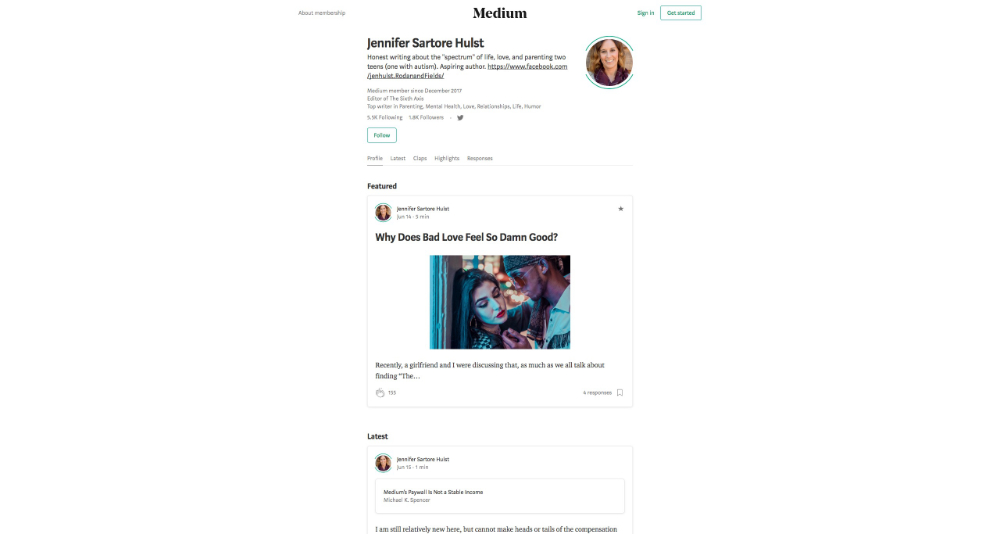
As a freelance journalist, an online presence is essential. There is no use calling or emailing a commissioning editor with earth-shattering feature ideas if they have never heard of you and have no proof you can deliver on your promises. Having a solid portfolio online will also help your application for a staff job, as any prospective editor will want to see your work before even considering replying to you.
Social media is a great place to start. Platforms such as Twitter, LinkedIn, Facebook, TikTok, Pinterest or Instagram are all great for personal brand-building, but there are many others out there that you might not have heard of – that might suit your needs better.
With that in mind, why not give these sites a go:

You get your own Clippings.me URL as standard and can link to your work with some nice big pictures to make it stand out, divided into different topics if necessary. There is an option to upload PDFs as well or embed various forms of multimedia from YouTube, Vimeo or SoundCloud. Creating a profile is also easy - just link your Twitter account and automatically import your bio and avatar.
Read also: How freelance journalists can make the most out of social media
Add your other social media links and some personal information and you are set. Journalist Katie Gatens and Clippings.me founder Nicholas Holmes, a freelancer himself, have some tips for general portfolio building if you want some more help.
A basic profile with a certain number of 'clippings' is free, but there are extra options – custom domain, spam-protected email, and Google Analytics integration – with the Premium account ($9.99/month).

About.me is not as journalism-focused as some of the other sites here but is just as useful in being a quick, one-page home for personal and professional information.
Add a great background image, some personal info, social media links and article links to create a simple profile. A pro version for $8 a month allows you to have your own domain name; book meetings with your Google account; get a portfolio, testimonials and video page; and remove the about.me branding.

Founder Marc Samson told Journalism.co.uk that Pressfolios serves three functions: "The first function is as a website builder, the second function is the personal repository and lastly the PDF uploader."
It sits somewhere between Clippings.me and About.me in its presentation. The profile page starts with a cover picture, links to social accounts, and a quick bio before a selection of article links or PDFs and an 'about' section at the bottom of the page that also features a LinkedIn-like list of skills. There is also a handy button which allows people to email questions and commissions directly to you.
After a free 14-day trial, you will need to pay $14.99 a month .

MuckRack was created as a professional directory for the media industry. Its scope grew over the years and it now offers a free portfolio function for journalists as well as some other useful features.
You can connect your different social media accounts, upload or link stories directly. "Our system will pull in links from any URL a journalist publishes to," Gregory Galant, MuckRack founder and CEO, told Journalism.co.uk. "A lot of freelancers love MuckRack for that."
An alert also notifies you when your stories are picked up or tweeted. Or you can be proactive and look up your own work to see who shared your links on social media.
Although it does not have the same slick presentation as other sites here, it is a great option for networking, connections and ease of use for slightly more established media professionals. The platform is free for journalists.

A cross between a website builder and the one-page option available on some other sites, Journo Portfolio looks great on desktop as well as on mobile, and is intuitive in adding articles. You can also add your CV and allow people to comment on your articles to get feedback or start discussions.
With JournoPortfolio, you can switch the layout between a grid, column, blog or gallery, choose different themes, and add extra pages to your portfolio to make it as simple or extensive as necessary. You can also track your progress with analytics or backup your articles in case the original website shuts down.
The free option gives you 10 articles and a branded URL. For £3.75 a month, you get unlimited articles and pages, and the Pro version for £6.75 a month comes with a custom domain, article backups and automatic article import. Students get a 50 per cent discount and charities get a Pro plan for free.

More of a website builder than a portfolio site in itself, Wix.com focuses on the big images and tidy layout so de rigeur of modern websites.
You can edit hundreds of existing templates or create an original website, with more options and add-ons than you could possibly ever need. One of the best features is the possibility to add any number of pages and link them to the main menu that you can place pretty much anywhere on your website, allowing for creative design.
There is a host of pricing options starting at £4/month, depending on your needs.

If you want to be more serious about site building then WordPress is another choice you can go for.
There are thousands of themes available to customise, but even with this head-start WordPress can become quite complex in getting what you want. However, there is plenty of online support available to help you navigate website building.
Building your site on WordPress can be very useful in terms of using and practising HTML and CSS code, which is a skill increasingly in demand across the media sector. The options are limitless when you know what you are doing. You can start for free, a personal plan costs £3 a month and Premium, which is recommended for freelancers, £7 a month if billed yearly.

Medium takes the hassle out of publishing by just letting you get on with adding the text and images you want.
The website has a simple, clear and attractive layout for publishing with big, full-window images and notes (comments) left alongside the text by authors and readers. This portfolio can also earn you some pennies, as Medium funds authors and publishers whose content is read by the website’s members, especially if they ‘clap’ for you.

In the same vein as Wix and WordPress, Squarespace is a simple drag-and-drop website builder that prioritises sleek visual experience over gimmicks. Although it offers far fewer templates than other website builders, there are still plenty of options to choose from – a great place to start if you want to build a customised website minus the headache. Some £10 a month will get you unlimited pages, galleries, website metrics, blogs and storage, and even a free custom domain if you commit for a year.

This Pinterest-style tool allows you to collect articles, videos, pictures or tweets from all around the web and organise them nicely into collections that you can re-order at any time. Probably the best option for those who do not want to spend time putting together a portfolio website but still want to showcase their online work on one easily accessible page. Best of all, it is free.
Feel free to tweet us with any other suggestions for portfolio or publishing platforms for journalists.
If you are a freelancer, you can advertise your services here, read more useful tips, and join our training on copywriting for freelance journalist.
Note: This story is an updated version of an article originally published on 19 November 2014 by Alastair Reid.
Do you want to become a successful freelancer? Learn new skills and get a certificate in freelance feature writing, pitching, copywriting, sub-editing and more. Click here for more information
Free daily newsletter
If you like our news and feature articles, you can sign up to receive our free daily (Mon-Fri) email newsletter (mobile friendly).
Related articles
- 'Give freelance journalists the due respect - and money - we deserve'
- Seven tips for using LinkedIn as a freelance journalist
- Three free AI-powered transcription tools for journalists
- OMG is it that time again? The tax troubles of a freelancer
- How to build a successful working relationship with editors









